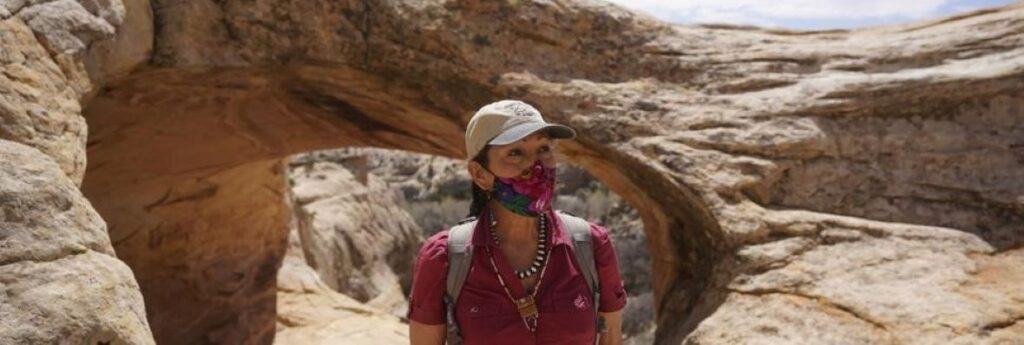US President Joe Biden is restoring two sprawling national monuments in Utah that have been at the centre of a long-running public lands dispute, and a separate marine conservation area in New England that recently has been used for commercial fishing. Environmental protections at all three monuments had been stripped by Donald Trump during his tenure.
The monuments cover vast expanses of southern Utah where red rocks reveal petroglyphs and cliff dwellings and distinctive buttes bulge from a grassy valley. In 2017, Trump invoked the century-old Antiquities Act to cut 800,000 hectares from the two monuments, calling restrictions on mining and other energy production a “massive land grab” that “should never have happened.”
His actions slashed Bears Ears, on lands considered sacred to Native American tribes, by 85%, to just over 80,900 hectares. They cut Grand Staircase-Escalante by nearly half, leaving it at about 405,000 hectares. Both monuments were created by Democratic presidents.
The White House said in a statement that Biden was “fulfilling a key promise” to restore the monuments to their full size and “upholding the longstanding principle that America’s national parks, monuments and other protected areas are to be protected for all time and for all people.”
His actions were among a series of steps the administration has taken to protect public lands and waters, the White House said, including moves to halt oil leasing in Alaska’s Arctic National Wildlife Refuge and prevent road-building in the Tongass National Forest in Alaska, the nation’s largest federal forest.
Biden’s plan also restores protections in the Northeast Canyons and Seamounts National Monument in the Atlantic Ocean, southeast of Cape Cod. Trump had made a rule change to allow commercial fishing at the marine monument, an action that was heralded by fishing groups but derided by environmentalists who pushed Biden and Interior Secretary Deb Haaland to restore protections against fishing.
Protecting the marine monument safeguards “this invaluable area for the fragile species that call it home” and demonstrates the administration’s commitment to science, said Jen Felt, ocean campaign director for the Conservation Law Foundation.
Arizona Rep. Raul Grijalva, a Democrat and chairman of the House Natural Resources Committee, also praised the Biden administration in a statement, saying restoring the monuments shows its dedication to “conserving our public lands and respecting the voices of Indigenous Peoples.”
“It’s time to put Trump’s cynical actions in the rear-view mirror,” Grijalva said.
But Utah’s governor called Biden’s decision a “tragic missed opportunity.” The president’s action “fails to provide certainty as well as the funding for law enforcement, research and other protections which the monuments need and which only Congressional action can offer,” Cox said in a statement released with other state leaders.
Jennifer Rokala, executive director of the Center for Western Priorities, a conservation group, also applauded Biden’s decision and said she hopes it marks an initial step toward his goal of conserving at least 30% of US lands and ocean by 2030.
Trump’s cuts ironically increased the national attention to Bears Ears, Rokala said. She called on the federal government to boost funding to manage the landscape and handle growing crowds.
Haaland, the first Indigenous Cabinet secretary, travelled to Utah in April to visit the monuments, becoming the latest federal official to step into what has been a years-long public lands battle. She submitted her recommendations on the monuments in June.
“The historical connection between Indigenous peoples and Bears Ears is undeniable; our Native American ancestors sustained themselves on the landscape since time immemorial, and evidence of their rich lives is everywhere one looks,” said Haaland, a member of the Laguna Pueblo in New Mexico.
Former President Barack Obama proclaimed Bears Ears a national monument in 2016, 20 years after former President Bill Clinton moved to protect Grand Staircase-Escalante. Bears Ears was the first site to receive the designation at the specific request of tribes.
The Trump administration’s reductions to Bears Ears and Grand Staircase-Escalante paved the way for potential coal mining and oil and gas drilling on lands that were previously off-limits. However, activity was limited because of market forces.
Environmental, tribal, paleontological, and outdoor recreation organizations sued to restore their original boundaries, arguing presidents lack legal authority to change monuments their predecessors created. Meanwhile, Republicans argued Democratic presidents have misused the Antiquities Act signed by President Theodore Roosevelt to designate monuments beyond what’s necessary to protect archaeological and cultural resources.
The Biden administration has said the decision to review the monuments was part of an expansive plan to tackle climate change and reverse the Trump administration’s “harmful” policies.

